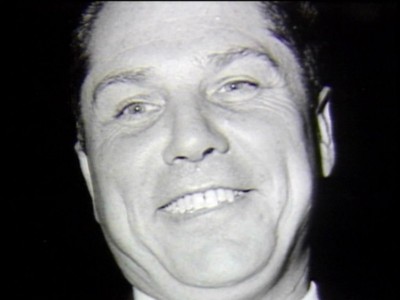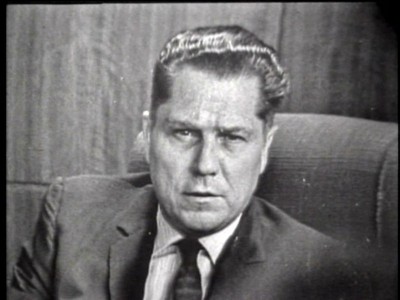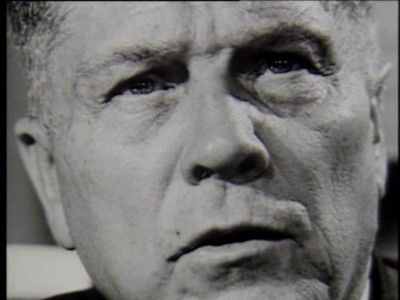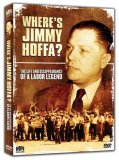| Reviews & Columns |
|
Reviews DVD TV on DVD Blu-ray 4K UHD International DVDs In Theaters Reviews by Studio Video Games Features Collector Series DVDs Easter Egg Database Interviews DVD Talk Radio Feature Articles Columns Anime Talk DVD Savant Horror DVDs The M.O.D. Squad Art House HD Talk Silent DVD
|
DVD Talk Forum |
|
|
| Resources |
|
DVD Price Search Customer Service #'s RCE Info Links |
|
Columns
|
|
|
Where's Jimmy Hoffa? The Life and Disappearance of a Labor Legend
You won't find out from this documentary. Putting aside that misleading title, though, MPI Home Video's Where's Jimmy Hoffa? The Life and Disappearance of a Labor Legend is actually an informative, unpretentious examination of the famed labor organizer's life that only gets fuzzy when it tries to answer its own title's question. Produced in 1992 (commissioned, I would imagine, to capitalize on the big-screen Danny DeVito/Jack Nicholson Hoffa bio that same year), Where's Jimmy Hoffa? The Life and Disappearance of a Labor Legend avoids all the bells and whistles we've now come to associate with cable documentaries (expensive recreations, maps, graphs, CGI effects, location shooting) to present a straightforward, "talking heads" look at American Labor's most controversial leader.

Beginning with his first job for the Kroger grocery chain in Detroit, Michigan, Where's Jimmy Hoffa? The Life and Disappearance of a Labor Legend details how Hoffa came to union organizing as a means of economic survival; after successfully negotiating a contract for his fellow works at Kroger, Hoffa a few years later went into full-time unionizing for the International Brotherhood of Teamsters at the height of the Depression. Fighting off incursions by the Mine Workers Union and the CIO Raiders, Hoffa went for the first time to the Mafia (who was aiding management in its fight against the UAW) to get rid of the CIO.
Where's Jimmy Hoffa? The Life and Disappearance of a Labor Legend then moves on to Hoffa's election at the head of the Teamsters in 1957, gaining the position in part through his formidable interpersonal skills with the rank and file, who came to idolize the tough, scrappy leader (reportedly, Hoffa knew many of the hundreds of union officials - and quite a few of just the rank and file members - by name). Through Hoffa's often pugnacious negotiating, the rank and file members experienced a surge in their income, bringing the former lowly paid workers solidly into the middle class. With his National Master Freight Agreement - the first union agreement ever to cover country-wide operations for a single union - Hoffa's efforts on behalf of his members resulted in burgeoning wealth for the truckers and other members of the Teamsters, as well as increased personal power for Hoffa. In all, Hoffa controlled over 1.6 million Teamsters, and could bring America to an economic halt on the threat of a strike.
Needless to say, that kind of personal power (Hoffa also rewrote the Teamster constitution in 1961, giving himself unprecedented administrative power) attracted attention both from the government and from organized crime - as well as providing a temptation for Hoffa to abuse that power. Soon, Hoffa was executing "sweetheart" deals with companies that benefited Hoffa and the union organization more than the rank and file members. The Teamster Pension fund, lauded to members as their security blanket when they became too old or too sick to work, soon became known as "the Mafia Bank," with loans made through mobsters to gambling organizations in Las Vegas (loans that proved highly profitable to the union). Unfortunately for many union workers, the offshoot of these loans was increasing infiltration of the union by gangsters, who mistreated locales and their members
The government took notice of all this, and went after Hoffa personally. Robert Kennedy, then Attorney General, took pains (many state he used illegal means) to nail Hoffa, eventually indicting Hoffa for bribery (first for trying to bribe a lawyer connected with the Senate Rackets Committee and then for Test Fleet Company fiasco in 1962, where Hoffa accepted bribes on behalf of a trucking company he had invested in). Additionally, Hoffa was caught running a land-swindle deal - to his own union members - down in Florida (the Sun Valley scheme), for which his own union members forgave him (such was the strength of their loyalty to Hoffa). Eventually, he was indicted for bribery in connection with a case involving the illegal use of the pension fund, and was sentenced to 13 years in federal prison. Beginning his sentence in 1964, Hoffa served time until his sentence was commuted by President Nixon at the end of 1971, on the condition he stay out of all union activity for a period of ten years. According to multiple accounts, Hoffa eventually worked his way back into a position where he wanted to challenge that ruling and come back as the head of the Teamsters, but on July 30, 1975, at the Machus Red Fox Restaurant in Bloomfield Township, Michigan, Jimmy Hoffa, on his way to meet two Mafia leaders (Anthony Giacalone and Anthony Provenzano), disappeared and was never seen again.

What I enjoyed most about Where's Jimmy Hoffa? The Life and Disappearance of a Labor Legend was its resolutely old-fashioned approach to the documentary framework. This is old-school documentary making, relying strictly on "talking heads" interviews with authors, historians, and people who worked with Hoffa. Occasionally, there are brief linking passages (utilizing stock footage of trucks or newsreels of period locales) that employ an anonymous narrator, but these are limited, with the majority of the doc focusing strictly on the interviews. Copious amounts of newsreel footage is used over the interviewees' words, keeping the visual design of Where's Jimmy Hoffa? The Life and Disappearance of a Labor Legend from getting static. Speakers on Where's Jimmy Hoffa? The Life and Disappearance of a Labor Legend include Hugh McCann, a former reporter for The Detroit Free Press; Arthur A. Sloane, author of Hoffa; Bobby Holmes, former president of the Teamster Joint Council; Rolland McMaster, former Teamster official; Carl Glines, former editor of Commercial Carrier Journal; Dan Moldea, author of Hoffa Wars; John Olszewski, a former IRS agent; Jan LaBotz, author of Rank and File Rebellion; Joseph Konowe, former Director of the Industrial Trades Division of the Teamsters; Richard Hammer, author of Hoffa's Man, and James Jones, former Bureau Chief of Newsweek. They know their stuff, and their combined interviews give Where's Jimmy Hoffa? The Life and Disappearance of a Labor Legend a surprising depth of knowledge in the relatively short (84 minute) running time.
That short running time also works to Where's Jimmy Hoffa? The Life and Disappearance of a Labor Legend's favor: it's clear and concise. Of course not everything is discussed here (the leap between the years of his initial organizing and his eventual ascension to the presidency of the union seems rather abrupt), but for anyone new to Hoffa's history, Where's Jimmy Hoffa? The Life and Disappearance of a Labor Legend is an excellent overview of his life. More importantly, the doc refuses to paint Hoffa in terms of being an absolute victim or absolute criminal. Depending on whom the viewer is listening to at the moment, Hoffa was either a saint working tirelessly for the rank and file members of the union; the devil himself, immersing the union in gangsterism and murder; or some creature inbetween the two extremes. It's up to the viewer to sift all the evidence and make his or her own mind up on what Hoffa's legacy was to the union and the American labor movement. The viewer will find a layered portrait of Hoffa here, which is admirable considering the polarity Hoffa seems to engender whenever his life and his deeds are analyzed and discussed.
Only when Where's Jimmy Hoffa? The Life and Disappearance of a Labor Legend begins to look at the (presumed) death of the labor leader does it lose some of its focus - but that's only because no one to this day knows exactly (or perhaps more correctly, is willing to tell) what happened to Hoffa in the parking lot of the Machus Red Fox restaurant in 1975. Listening to the umpteenth stories of what really happened to Hoffa, all supposedly based on solid testimony from unnamed sources, it becomes almost comical in its piled-on effect, as we hear how Hoffa absolutely was shot/beaten/ground-up/squished/buried/sunk. Considering the success of the content of the first part of the doc, perhaps it would have been better served to call the documentary, Who Was Jimmy Hoffa?, rather than its present title's question, which will, in all probability, never be answered.

The DVD:
The Video:
The full-screen, 1.33:1 video transfer for Where's Jimmy Hoffa? The Life and Disappearance of a Labor Legend is just about what you'd expect from MPI Home Video for a 16-year-old documentary. Grain is apparent, as is considerable video noise; with many of the original interviews apparently shot on video, this probably didn't look that good to start with. The picture is sharp enough, but colors can wash out, depending on the source material. Overall, a smaller monitor will do here.
The Audio:
The Dolby Digital English 2.0 stereo mix is more than enough for this dialogue-only doc, which features no separation effects whatsoever. No close-captions are available.
The Extras:
There are no extras for Where's Jimmy Hoffa? The Life and Disappearance of a Labor Legend.
Final Thoughts:
Clean and concise, Where's Jimmy Hoffa? The Life and Disappearance of a Labor Legend gives an excellent background history of the notorious labor leader, but it certainly doesn't answer the central riddle of its own title. Told in a thoroughly old-fashioned "talking heads" style, that doesn't matter at all, since the heads doing the talking know very well what they're talking about. I recommend the informative, unpretentious Where's Jimmy Hoffa? The Life and Disappearance of a Labor Legend.
Paul Mavis is an internationally published film and television historian, a member of the Online Film Critics Society, and the author of The Espionage Filmography.


|
| Popular Reviews |
| Sponsored Links |
|
|
| Sponsored Links |
|
|
| Release List | Reviews | Shop | Newsletter | Forum | DVD Giveaways | Blu-Ray | Advertise |
|
Copyright 2024 DVDTalk.com All Rights Reserved. Legal Info, Privacy Policy, Terms of Use,
Manage Preferences,
Your Privacy Choices | |||||||













